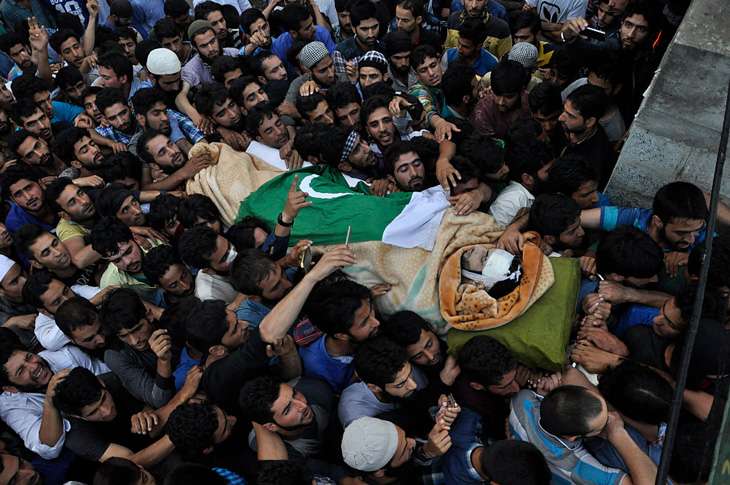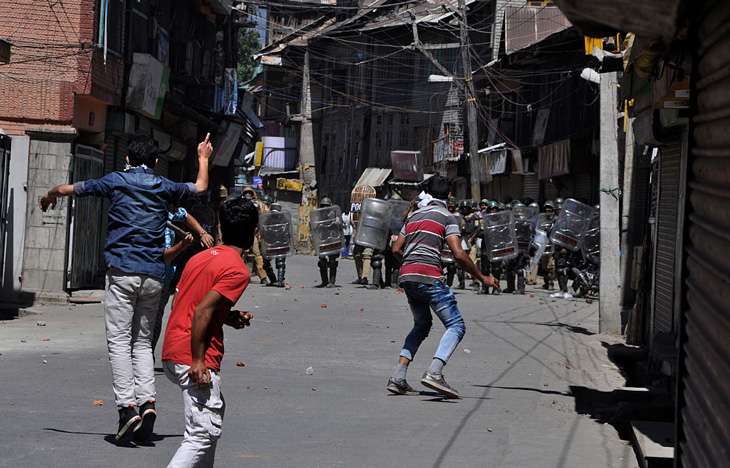Kashmir is drifting back to militancy. Do not take it lightly

- The Kashmir Valley has seen massive protests since the encounter killing of Hizb militant Burhan Wani
- Around 45 people have died, while thousands more have been maimed or injured
- New Delhi ought to be worried about these protests
- That\'s because unlike between 2008-2010, the protests show a renewed fascination for the gun
- Also, unlike in the past, the protests are not radiating outward from Srinagar
The ferocious protests in Kashmir since the death of Hizbul Mujahideen commander Burhan Wani are quite unlike those between 2008 and 2010.
These protests don't represent the public's transition from implicitly supporting the militant movement to agitating on the streets by itself. It's actually the reverse - the drift is now back in favour of militancy. There is a renewed fascination for the gun, largely because it now commands the same public respect and awe that it did in the early 1990s.
Over the past year, every militant funeral has inspired some youth to take up the gun. The unprecedented outpouring of grief and anger over Burhan's death and the readiness to die for his cause - fighting India - ought to give New Delhi sleepless nights.
Political vacuum
But why did this happen? Observers of Kashmir point to the political vacuum of the past five years.
"Street protests, which, since 2010, were restricted to some urban pockets, failed to yield any attention or a serious political engagement with Kashmir by New Delhi. Besides, routine azadi protests seemed to make little dent in the gathering normalcy discourse, which seemed to push the Kashmir conflict into the background. So, guns came back into vogue as an instrument that can keep the Kashmir issue in spotlight," says Naseer Ahmad, a local columnist.
"And just when people were despairing that two decades of revolt were giving way unaddressed to the return of normalcy and the ascendance of mainstream politics, Burhan Wani emerged on the scene to reclaim, remind and represent what has all along been wrong with Kashmir. People instantly identified with him."
Burhan, it is argued, romanticised the option of the gun, and offered an illusion of a sense of agency denied by the emasculated mainstream politics, which is perceived to kowtow more to New Delhi than articulate the grievances of their constituency.
In death, and the revolution-like mobilisation it has spawned, Burhan may have imparted some fresh moral glamour to the militancy.
From the countryside to Srinagar

Over the three successive summer unrests until 2010, protests had radiated outwards from Srinagar, with the summer capital in the thick of the action. So had the militancy, up until 2000.
The countryside would take a cue from the city, both in terms of militancy and protests. But that's no longer the case, as the ongoing protests will tell you.
Protests spilled over into Srinagar from south Kashmir, spread to the north and also to parts of Jammu.
The same is the case with the militancy. Srinagar's last militant, Sajad Ahmad Khan, was eliminated in 2010 in an encounter at Rajouri in Jammu province. One alleged militant from the city, though, was killed in a recent shoot-out at Kud on the Jammu-Srinagar highway. However, its circumstances continue to be shrouded in controversy.
Though it could very well be a temporary phenomenon, but this turmoil is largely about the eruption in the countryside. This should be no surprise considering, that almost all the fresh recruitment to militant ranks has come from the villages. Even Burhan hailed from Shariefabad, a village on the outskirts of Tral.
Attacks on security camps, police posts
Between 2008 and 2010, there were fewer attacks on army camps and police stations. But now, police stations, posts, army camps and even the Awantipora air base were attacked by the protesters.
Several police posts were burnt. The protesters set afire one police vehicle, and some seized vehicles at Lasipora Pulwama. Similarly, a Government Railway Police guard room and a Railway Protection Force barrack were torched at Bijbehara, as was a police post at Damhal Khushipora.
A single-storeyed structure at Soibugh Budgam, where a police post functioned in the past, was also burnt. One police vehicle was pushed into the Jhelum near Sangam, killing its driver.
And this has mostly been done by the protesters in the rural areas.
In 2010, hardline Hurriyat chief Syed Ali Geelani had asked people to protest outside the army camps, but had withdrawn the call when the army warned of consequences.
Highest number of deaths and injuries

In 2010, around 45 persons had died in two months of protests. Similarly, around 60 protesters were killed in more than three months of fierce azadi groundswell. The number of the injured had also been fairly low.
But this time, there have been 45 deaths in just one week. The number of the maimed and injured has reached more than 2,000.
By the government's own estimates, around 600 youth have received pellet injuries in the body or eyes - around 100 of those hit in the eyes stare at a partial or total blindness. Doctors at the Shri Maharaja Hari Singh hospital, Srinagar, have already declared six youth blind, including a 14-year-old girl, Insha Malik, from village Seedow of Shopian.
Around 125 have been hit by bullets, according to the figures presented by the state government to the High Court on 14 July. The number has since risen.
Pellet guns were deployed as part of the crowd control gear towards the end of the 2010 unrest. On 14 August 2010, the pump action rifle was used for the first time at Seelo Sopore on a 3,000-strong mob. Six persons were injured, according to a PTI report.
Proactive Pakistan
In 2010, Pakistan had been less proactive in its support to the unrest in the state. The then-Pakistan People's Party government watched the situation more or less from the sidelines. Its media was least interested in the developments.
But now, the Pakistan government has moved beyond the formal condemnation of the killings in Kashmir, and observed 19 July as a 'black day in solidarity with Kashmiris'.
Prime Minister Nawaz Sharif held a special cabinet meeting in Lahore on Tuesday to discuss the situation in Kashmir. He termed the "movement of Kashmiris as a movement of freedom", and also declared Burhan a martyr. Sharif has also decided to hold a special joint session of Parliament to discuss the ongoing trouble in the state.
What's more, the country's powerful army chief, General Raheel Sharif, also condemned the "brutal killings of innocent Kashmiri youth" by India in a statement issued at the end of the Corps Commanders' Conference at the General Headquarters in Rawalpindi.
Similarly, leading Pakistani newspapers like Dawn, Daily Times and The News have devoted more editorial space to reports from Kashmir. Opinion pieces and editorials have appeared in many newspapers.
On the whole, there are signs aplenty that this round of violence is unlike the previous few episodes. The theatres have shifted. It seems like the mood of the masses also has.
Edited by Shreyas Sharma
More in Catch
Vajpayee was less rigid than Modi vis-a-vis Kashmir: CPI(M) MLA Tarigami
Undeclared emergency in Kashmir: police seize newspapers, gag media
Kashmir turmoil in pictures: Protests and bandh keep the valley tense
First published: 19 July 2016, 10:50 IST




![BJP's Kapil Mishra recreates Shankar Mahadevan’s ‘Breathless’ song to highlight Delhi pollution [WATCH] BJP's Kapil Mishra recreates Shankar Mahadevan’s ‘Breathless’ song to highlight Delhi pollution [WATCH]](https://images.catchnews.com/upload/2022/11/03/kapil-mishra_240884_300x172.png)

![Anupam Kher shares pictures of his toned body on 67th birthday [MUST SEE] Anupam Kher shares pictures of his toned body on 67th birthday [MUST SEE]](https://images.catchnews.com/upload/2022/03/07/Anupam_kher_231145_300x172.jpg)






